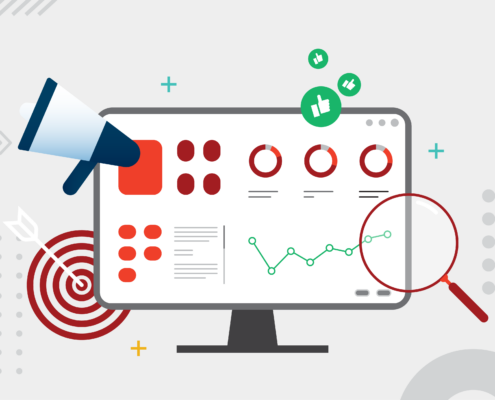

Many buyers are much more cautious of the way they spend their money these days, especially in the B2B market. With a potential recession on the rise, company decision-makers are making more financial decisions based on how it can benefit business growth—both internally and externally.
Generating more revenue is often a struggle for many businesses, which is why it’s important to follow the latest sales strategies. If you want to consistently grow your business predictably and sustainably, follow these sales best practices:
- Cater to Different Buyer Personas Through Online Selling
- Share Content That Establishes Your Company as a Thought Leader
- Look at Your Inbound Leads as Your Hottest Leads
- Provide an Immediate Benefit to the Potential Buyer
- Write and Distribute Personalized Sales and Marketing Materials
- Be Willing to Adapt—Keep the Prospect Top-of-Mind
- Upsell, Upsell, Upsell
Cater to Different Buyer Personas Through Online Selling
While you may have a single target market, consider all the different buyer personas that reside in it. One of the top sales strategies lead generation teams use to generate more revenue is to cater to the different buyer personas through online selling.
Online selling refers to a wide range of digital marketing practices like search engine optimization (SEO), search engine marketing (SEM), and social media advertising. These inbound lead generation practices allow you to reach potential buyers through different platforms that they may use and feel more comfortable with, rather than direct selling over the phone or through cold sales email marketing efforts.
If a decision-maker is actively looking for your product, service, or industry online, they’re more than likely looking to learn more about your business and potentially invest in what you have to offer. Rather than following a strict outbound lead generation program, online selling allows new prospects into the sales pipeline on their own time. This gives them the mindset that they’re more in control of their purchasing habits rather than being approached unwarrantedly by sales development representatives (SDRs).
Cold calling and direct email marketing are incredibly impactful sales strategies that companies use to get their business in front of potential buyers. However, online selling through SEO, SEM, and social media empower sales teams to reach new leads that they wouldn’t have initially caught in their outbound sales pipeline. This allows you to capture a new audience and learn about the way they go about making a purchase.
For example, if you’re not getting the leads you want from your cold calling and email marketing efforts, it may be because that approach to getting new sales opportunities doesn’t align with the buyer personas of your target market. This is what makes the initial target market research stage of lead generation such an important part of the sales process. Without first analyzing your target market and their buyer personas, you risk wasting a significant amount of time and money on a lead generation strategy that yields poor results.
Share Content That Establishes Your Company as a Thought Leader
When you share content that establishes your business and its employees as an industry-leading thought leader, you have a great opportunity to position yourself as a credible source and gain the trust of potential buyers.
Many small to medium-sized businesses in the past used to believe that the only way to attract potential customers was by sharing sales-focused content. While this may have been true at one point, more buyers today can see through the sales-heavy content and that you’re looking to make money rather than support their needs and provide a solution to their pain points. The content you share with prospects online and through your appointment setting efforts should be genuine and come from the perspective of industry leaders rather than from a brand’s social media account.
Credibility doesn’t just mean having a list of case studies shared on social media expressing why your product or service solution works. It also includes sharing the insights your company leaders have about the current state of the industry. This empowers decision-makers to believe and trust that you understand their unique challenges, and you’re not just a generalist in the subject matter—you’re an expert looking to make their everyday operations better.
Let’s take a look at our business for example. Rather than routinely posting content from the Abstrakt LinkedIn profile, we’ve spent more time generating thought leadership style content from the perspective of our leaders. Here’s an example post from our Founder and CEO, Scott Scully:

This post itself received much more engagement than any of our most recent posts on our company LinkedIn profile, leading to more brand awareness and establishing our business as a thought leader in the industry. For a look at the complete post, check it out on Scott’s LinkedIn profile here.
Look at Your Inbound Leads as Your Hottest Leads
As we mentioned earlier, potential buyers that come to your website are actively looking for a solution to their pain points. When an inbound lead comes in, they’re already interested in learning more about what you have to offer them. So, when you find an inbound lead, your SDRs should approach them as if they’re the hottest lead in the sales pipeline.
After a user submits their information to learn more about a specific product, service, or topic, SDRs must reach out as soon as possible via phone call or email to learn more about them and what they’re looking to learn more about. Even if they’re not ready to buy quite yet, the SDR can at least take this time to guide them in the right direction and give them the best customer service and user experience possible. This process of lead nurturing moves them through the sales funnel, reducing the amount of time it takes for them to convert from a lead into a sales opportunity.
Lead qualification is an essential part of having a healthy lead generation program. However, it’s approached differently between outbound and inbound lead generation. For instance, in an outbound appointment setting program, prospects are sales qualified. Then, SDRs reach out to generate interest and encourage them to schedule a sales meeting.
But when it comes to inbound lead generation, leads are first marketing qualified, then they become sales qualified after an SDR reaches out to confirm their sales qualifying criteria, such as size of commercial space, number of full-time employees, amount of yearly revenue generated, etc.
With outbound appointment setting, it can take weeks, months, or even years for a sales-qualified lead to also become a marketing-qualified lead. However, it takes a few simple lead qualifying questions to ensure a marketing lead is also a qualified sales lead. If an inbound lead is ready to take the next step in the buyer’s journey, the SDR can transfer the conversation from them to a sales or account executive so they can present them with a sales pitch that shows how your product or service can maximize their everyday business functions.
Provide an Immediate Benefit to the Potential Buyer
As human beings, we like immediate satisfaction. So, when trying to generate more sales for your business, you must provide the potential buyer with an immediate benefit.
A sales strategy report gathered by Hubspot data suggests that implementing free trials into sales development and marketing efforts are 76% more effective than other offerings, followed by a freemium offering that is 69% effective for converting prospects into customers.
Using sales and marketing messaging that highlights a free trial, demo, or audit gives prospects the opportunity to learn more about your solutions without making the commitment to sign a contract. These offerings give them an inside look into different ways you can support their business’s short- and long-term goals. If they see the value your company can bring to their business, they’re more than likely to sign on with you than a competitor that didn’t provide the exclusive inside look into their product or service solutions.
For example, at Abstrakt, prospects interested in our outbound lead generation solution receive a free demo of how we can implement our list building, outreach, and appointment setting efforts into their current strategy. On the other hand, when it comes to pitching our inbound lead generation solution to prospects, we offer decision-makers a free audit of their company website. This allows us to show them where they may have some weaknesses in their current website, and what can be done to use their website as an additional lead generator.
Write and Distribute Personalized Sales and Marketing Materials
If you want to succeed in the B2B market, it’s crucial that you write and distribute personalized sales and marketing materials to the different buyer personas within your target market.
When people think of personalizing sales and marketing content, they often think it just means including the prospect’s name in sales emails. While this may be a part of it, it’s so much more than including a name in a subject line. It includes understanding the prospect’s wants, needs, and pain points from the inside out.
Personalized sales and marketing materials include infographics, social media graphics (for organic and paid ads), landing pages, newsletters, and more. They can be used for every stage of the buyer’s journey from prospect awareness to retaining customers loyalty. Additionally, marketing collateral can be used for both appointment setting and digital marketing efforts, making them a crucial asset for every buyer persona, no matter how diverse their needs are.
When used for the awareness stage, personalized content may include taking a potential buyer’s pain points and converting them into a visually appealing design that captures their attention. Let’s say you’re a commercial HVAC company that wants to target business owners. A personalized sales and marketing graphic might highlight how routine maintenance can help them save money in the long run. Or if you want to target facility managers, the piece of marketing collateral might expand on how routine maintenance reduces the likelihood of heating and cooling system breakdown.
Whatever the buyer persona of the potential buyer or their stage in the buyer’s journey, marketing collateral can help meet them where they’re at, reducing the amount of time they spend in the sales cycle.
For an inside look into the best marketing collateral for each stage of the buyer’s journey, download our guide here.
Be Willing to Adapt—Keep the Prospect Top-of-Mind
If you serve a common industry, it can be difficult to make your company stand out from competitors. Therefore, you must be willing to adapt to what prospects want from your business. Keeping prospects top-of-mind and making adjustments based on their needs is essential for generating more sales and keeping existing clients happy.
Let’s take the commercial cleaning industry for example. Before COVID-19, the commercial cleaning industry didn’t have a want or need for electrostatic disinfection cleaning. But it quickly became a necessary service they needed to offer their customers as a response to the pandemic. Without electrostatic disinfection cleaning services, commercial cleaning companies risked losing a huge portion of their clients because many people were hesitant to go back into office spaces.
While this is one of the more recent examples of industry adaptation, the same is true for many businesses in different industries. If your sales reps and marketing specialists are seeing a lot of new trends within your industry that prospects are asking for, it’s important to adapt sooner rather than later. This shows that your company is willing to adapt quickly to the requests of buyers and put their needs before their own.
Upsell, Upsell, Upsell
And last but not least, if you want to generate more sales, upsell your current book of business.
Current clients know how impactful your products or services are to their everyday business operations. If they didn’t, they could easily take their business elsewhere. While upselling is often a forgotten sales strategy in the B2B market, it’s incredibly important for customer retention, and increasing the likelihood of them becoming a referral for leads in the pipeline.
Key Takeaways
Generating revenue in the B2B atmosphere isn’t easy, especially in today’s market. While many companies believe this is the time to cut the sales and marketing budget, it’s actually the perfect time to invest more in your sales and marketing efforts. Without a consistent stream of leads coming in, you risk losing your business altogether.
Abstrakt Marketing Group collaborates with growing B2B companies around the nation to help them fill their sales pipelines with qualified leads. After prospecting and qualifying prospects, our SDRs are well-equipped to follow up and discover what they’re looking for in a product or service provider. When you’re ready to maximize your sales strategy and secure more revenue for your business, contact the lead generation experts at Abstrakt!




